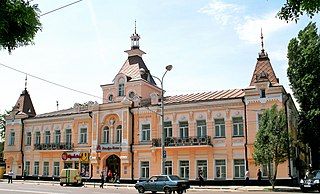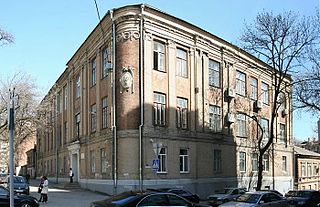
The White House, also known as the Russian White House and previously known as the House of Soviets of Russia, is a government building in Moscow. It stands on the Krasnopresnenskaya Embankment. The building serves as the primary office of the government of Russia and is the official workplace of the Russian Prime Minister.

Rostov-on-Don is a port city and the administrative centre of Rostov Oblast and the Southern Federal District of Russia. It lies in the southeastern part of the East European Plain on the Don River, 32 kilometers (20 mi) from the Sea of Azov, directly north of the North Caucasus. The southwestern suburbs of the city lie above the Don river delta. Rostov-on-Don has a population of over one million people and is an important cultural centre of Southern Russia.

Rostov Arena is an association football stadium in Rostov-on-Don, Russia. It was one of the venues for the 2018 FIFA World Cup. It also hosts FC Rostov of the Russian Premier League, replacing Olimp – 2. It has a capacity of 45,000 spectators.

The Paramonov Mansion is a mansion in the city of Rostov-on-Don. It was built in 1914 for book publisher Nikolai Paramonov. The mansion was designed by architect Leonid Aeberg. The building is currently occupied by the Y. A. Zhdanov Scientific Library of Southern Federal University. The design is an example of Neoclassical architecture and is considered to be an architectural monument of federal importance.
Orthodox churches in Rostov-on-Don were built during the 17th–20th centuries; they played a role in shaping of the architectural appearance of Rostov-on-Don. They created the high-altitude dominants.

The Shenderov House is a historic house in Rostov-on-Don and is today the Alfa-Bank branch. The house is located at 33 Voroshilovsky avenue in the Kirovsky District of Rostov-on-Don. The building is also considered to be an object of cultural heritage.

The Gench-Ogluev House is a historic house in the Leninsky District of Rostov-on-Don, Russia. The house is located at 68 Bolshaya Sadovaya Street, at the intersection of Bolshaya Sadovaya Street and Semashko Lane, directly opposite the Rostov-on-Don City hall. The building has the status of an object of cultural heritage of federal significance.

The Chernov House is a building in the Kirovsky City District of Rostov-on-Don, Russia. The house is located at 69 Bolshaya Sadovaya Street at the intersection of Voroshilovsky Prospekt and Bolshaya Sadovaya Street. It was a revenue house. The building has the status of an object of cultural heritage of Russia of regional significance.

The House of Soviets is an administrative building in the centre of Rostov-on-Don built in Stalinist style in the late 1930s. By the beginning of the Great Patriotic War the House of Soviets had not yet been fully completed. Repair and restoration work were carried out only in the 1950s, and the facades of the building were completed only in 1968. The total volume of the Rostov House of Soviets is 370,000 cubic meters, which makes it one of the largest buildings in the North Caucasus and the largest administrative structure in Southern Russia.

Lyceum № 13 is a municipal general educational establishment in Rostov-on-Don. The school's building was designed in 1892 by the architect Nikolai Durbakh. It originally housed the Ekaterininskaya Women's Gymnasium of Nakhichevan-on-Don. The building has the status of an object of cultural heritage of regional significance.

N. A. Semashko City Hospital No. 1 is a large hospital in Rostov-on-Don.

The North Caucasus Railway Administration Building is a building in Rostov-on-Don at Teatralnaya Square constructed from 1911–1913 in the Art Nouveau style. The building has the status of an object of cultural heritage of Russia of regional significance.

Soviets Square or Sovetov Square is a city square of Rostov-on-Don, situated in Kirovskiy District at the intersection of Bolshaya Sadovaya Street, Voroshilovsky Avenue, Sokolova Avenue and Sotsialisticheskaya Street.

The Monument to the 1st Cavalry Army is a monument in Rostov-on-Don, Rostov Oblast, Russia. It was built in 1972 on the project of architect Evgeniy Vuchetich and is situated at the centre of the Soviets Square. It is dedicated to the soldiers of the Red Army who in 1920 defeated the White forces and took the city. The monument has the status of an object of cultural heritage of regional significance.

Trading house of G.G. Pustovoytov is a building in Rostov-on-Don at the intersection of Bolshaya Sadovaya and Budennovskiy avenue.

The Masalitina House, also known as the Vorozhein House is a building in Rostov-on-Don located at the intersection of Bolshaya Sadovaya Street and Kirovsky Prospekt. It was built in 1890 to the design of architect Grigory Vasilyev in the eclectic style. At the beginning of the 20th century, the house belonged to the merchant P. K. Masalitina. The building is currently occupied by the restaurant "New York". The Masalitina House has the status of an object of cultural heritage of regional significance.

The Ivan Zvorykin House is a building in Rostov-on-Don located at the intersection of Pushkinskaya Street and Semashko Lane. It was built in 1914 to the design of architect Vasily Popov. In the period of the Russian Empire, the house was the office and residence of Rostov-on-Don's mayor, major-general Ivan Nikolayevich Zvorykin. Soviet playwright Vladimir Kirshon lived in the house between 1923 and 1926. The building has the status of an object of cultural heritage of regional significance.

The Kechekyan Mansion is a building in Rostov-on-Don located at Liberty Square. It was constructed in the third quarter of the 19th century on the central square of the city of Nakhichevan-on-Don. The mansion is currently occupied by the A. S. Pushkin Children's Library. The building has the status of an object of cultural heritage of regional significance.

School № 49 (Russian: Школа № 49 is a secondary school in Rostov-on-Don. The building was constructed in the 1910s based on a design by architect V. V. Popov Sr. in the Art Nouveau style. The school's building has been designated a cultural heritage site.

Rostov Hotel is a hotel in Rostov-on-Don. It was built in 1934 in the style of Soviet constructivism by the architects Ilya Cherkessian, Khachatur Chalkhushyan and Leonid Eberg. It is the oldest operating hotel in Rostov-on-Don. The building is currently occupied by Marins Park Hotel Rostov.






















